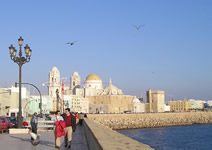 Cadiz claims to be the oldest city in Europe, having
been founded around 1100BC by the Phoenicians. With the discovery of the
New World, and Cadiz’s monopoly on trade with the Americas (it was
the headquarters of the Spanish treasure fleets), this became the wealthiest
port in Western Europe. Many of its historical buildings date from this
era. It certainly has its fair share of historic sights for the visitor,
especially the beautiful gold-domed Cathedral and the Torre de Tevira. This
was built in the 18th century, and contains a fantastic Camera Obscura which
works like a periscope and shows panoramic views of the whole city.
Cadiz claims to be the oldest city in Europe, having
been founded around 1100BC by the Phoenicians. With the discovery of the
New World, and Cadiz’s monopoly on trade with the Americas (it was
the headquarters of the Spanish treasure fleets), this became the wealthiest
port in Western Europe. Many of its historical buildings date from this
era. It certainly has its fair share of historic sights for the visitor,
especially the beautiful gold-domed Cathedral and the Torre de Tevira. This
was built in the 18th century, and contains a fantastic Camera Obscura which
works like a periscope and shows panoramic views of the whole city. |

|

